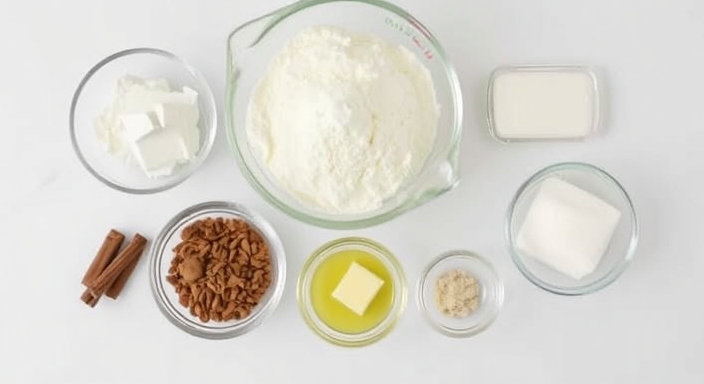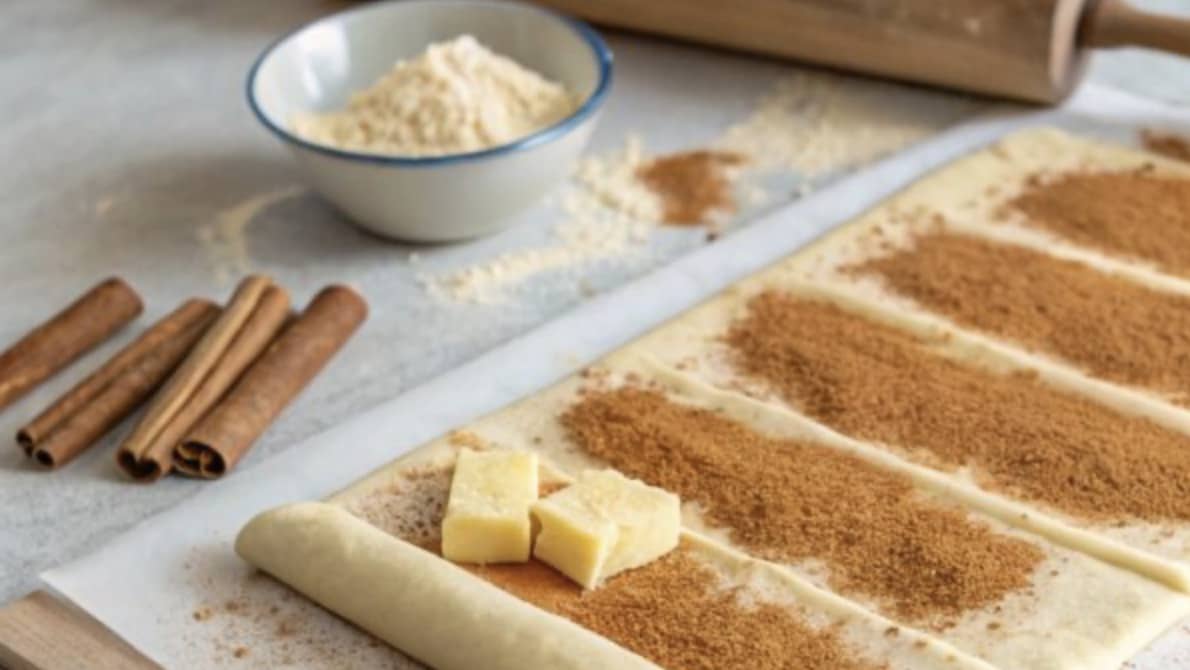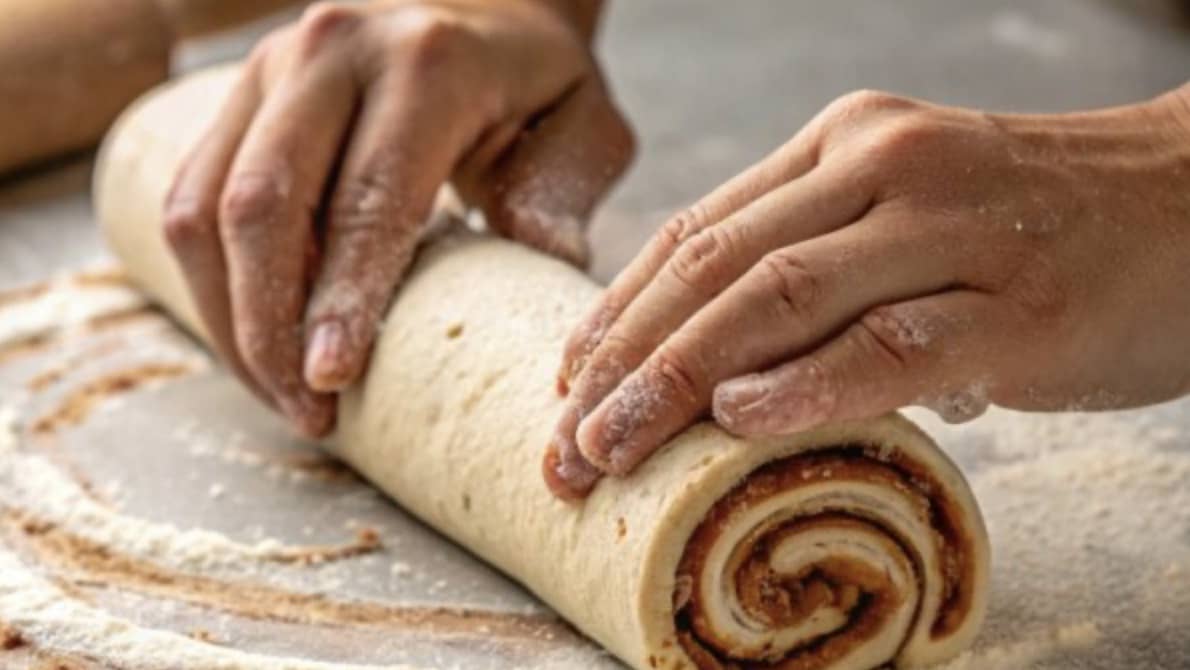Who doesn’t love cinnamon rolls? They’re warm, gooey, and downright comforting. But have you ever tried sourdough cinnamon rolls? 🥖✨ These rolls take your favorite treat to a whole new level. With a tangy depth of flavor that perfectly balances the sweetness of the cinnamon filling, they’re a must-try for any baking enthusiast.
In this guide, we’re diving deep into everything you need to know about sourdough cinnamon rolls. From starting your sourdough journey to crafting the fluffiest rolls and troubleshooting common issues, this article has you covered. So grab your apron—let’s roll (pun intended)!
Table of contents
What Are Sourdough Cinnamon Rolls?
Sourdough cinnamon rolls are a delightful twist on the classic cinnamon roll. Instead of using commercial yeast for leavening, these rolls rely on a natural sourdough starter. This starter is a mix of flour and water that ferments over time, creating wild yeast and bacteria. Sounds like science? That’s because it is—but don’t worry, it’s easier than it sounds!
The result? Rolls with a unique tangy flavor, a soft texture, and a longer shelf life compared to traditional versions.
Why Choose Sourdough for Cinnamon Rolls?
The Benefits of Using Sourdough Starter
Let’s face it: baking with sourdough is like having a magical pet in your kitchen. 🪄 Here’s why sourdough cinnamon rolls are worth the hype:
- Healthier Option: Sourdough is easier to digest because fermentation breaks down gluten and increases nutrient availability.
- Enhanced Flavor: That slight tang adds a layer of complexity to the rolls that regular dough just can’t match.
- No Commercial Yeast Needed: Ideal for those who prefer natural leavening or can’t find yeast at the store.
Flavor Profile: Sourdough vs. Traditional Dough
Think of sourdough cinnamon rolls as the grown-up version of your childhood favorite. While regular cinnamon rolls are sweet and rich, sourdough rolls add a subtle tang that balances the sugar and spice perfectly. It’s like the difference between sweet milk chocolate and dark chocolate—both are delicious, but one has a little extra depth.
Ingredients Needed for Sourdough Cinnamon Rolls

Before we get our hands dirty, let’s talk ingredients. Spoiler: you probably already have most of these in your pantry!
Essential Ingredients
Here’s what you’ll need:
- Sourdough Starter: The heart and soul of these rolls.
- All-Purpose Flour: Provides structure to the dough.
- Milk: Adds richness and moisture.
- Butter: Because what’s a cinnamon roll without buttery goodness?
- Eggs: Help bind the dough and give it a tender texture.
- Sugar: For that touch of sweetness in the dough.
- Cinnamon: The star of the filling.
- Brown Sugar: Adds depth and caramel-like sweetness to the filling.
Optional Add-Ons for Customization
Feeling adventurous? Try these:
- Chopped Nuts: Walnuts or pecans for a crunchy twist.
- Raisins or Dried Cranberries: A chewy surprise in every bite.
- Orange Zest: For a citrusy kick.
- Chocolate Chips: Because why not?
“Baking is both an art and a science—feel free to experiment and make these rolls your own!”
How to Make a Sourdough Starter from Scratch
Before we dive into the dough, let’s talk about the MVP of this recipe: the sourdough starter. If you don’t already have one bubbling away on your countertop, don’t worry! Here’s how to make it from scratch.
Step-by-Step Process for Sourdough Starter
- Day 1: Mix 1/2 cup of all-purpose flour with 1/4 cup of water in a jar. Stir well and cover loosely with a lid or cloth. Leave it at room temperature.
- Day 2: Discard half of the mixture and feed the starter with the same ratio of flour and water (1/2 cup flour, 1/4 cup water). Stir and let it sit.
- Days 3–7: Repeat the feeding process daily. By the end of the week, your starter should be bubbly and smell tangy. It’s ready to use!
Tip: If your starter isn’t bubbling after a few days, don’t panic. Sometimes, it just needs a bit more time or warmth.
Common Problems and Solutions with Starters
- It Smells Bad: A strong smell is normal, but if it smells rotten, toss it and start over.
- No Bubbles: Place the jar in a warmer spot and feed it twice a day to kickstart fermentation.
- Mold Growth: Discard immediately and begin fresh. Cleanliness is key!
Preparing the Dough for Sourdough Cinnamon Rolls

Once your starter is ready, it’s time to create the dough. This part is where the magic begins.
Step-by-Step Dough Preparation
- Mix the Ingredients: Combine 1 cup of active sourdough starter, 3 cups of flour, 1/2 cup milk, 1/4 cup sugar, 1 egg, and 1/4 cup softened butter in a large bowl.
- Knead the Dough: Knead by hand for 8–10 minutes or use a stand mixer with a dough hook for 5–7 minutes. The dough should be soft and slightly sticky.
- First Rise: Place the dough in a greased bowl, cover with a damp towel, and let it rise for 6–8 hours or overnight. It should double in size.
Troubleshooting Sticky or Overworked Dough
- Too Sticky: Add a tablespoon of flour at a time until the dough is manageable, but don’t overdo it—you want the dough to stay soft.
- Too Dry: If the dough cracks, add a teaspoon of milk and knead gently.
- Overworked Dough: Let it rest for 10 minutes to relax the gluten.
“Dough too sticky? Think of it like life—it just needs a little patience and a light touch. Don’t rush it!”
Crafting the Perfect Cinnamon Filling
Let’s talk about the heart of every cinnamon roll: the filling. This is where the magic happens.
Best Cinnamon-to-Sugar Ratio
For the ideal filling:
- 2 tbsp Cinnamon: The warm, spicy star of the show.
- 1/2 cup Brown Sugar: Sweet and slightly caramel-like.
- 2 tbsp Softened Butter: Helps everything stick and adds richness.
Creative Filling Additions
Want to elevate your cinnamon rolls? Try these:
- Chopped Nuts: Add crunch with pecans or walnuts.
- Dried Fruits: Raisins, cranberries, or even chopped dates for added sweetness.
- Spices: A pinch of nutmeg or cardamom for a unique flavor twist.
Rolling, Shaping, and Cutting Cinnamon Rolls

Here comes the fun part—turning that dough into perfectly shaped rolls. Ready? Let’s roll (literally)!
Techniques for Even Rolls
- Roll Out the Dough: Lightly flour your surface and roll the dough into a rectangle about 1/4 inch thick.
- Spread the Filling: Brush the dough with melted butter, then sprinkle your cinnamon-sugar mixture evenly across the surface.
- Roll It Up: Starting from one long edge, tightly roll the dough into a log.
- Slice into Rolls: Use a sharp knife or unflavored dental floss to cut 1-inch thick slices.
Avoiding Filling Spillage
- Don’t overfill! Too much filling will spill out as you roll.
- Chill the dough slightly before cutting—it helps keep the filling in place.
- Roll the dough tightly but not too tight; you don’t want the rolls to unravel.
Pro Tip: Use dental floss for clean, perfect cuts. Just loop it under the roll, cross the ends over the top, and pull!
Proofing the Rolls: Getting the Timing Right
Patience is key during the proofing stage. This step ensures the rolls are light and fluffy.
How to Know When Rolls Are Ready to Bake
- Size: The rolls should puff up and nearly double in size.
- Bounce Test: Gently press the dough—if it springs back slowly, it’s ready to bake.
Common Mistakes During Proofing
- Under-Proofed Rolls: They’ll be dense and won’t rise properly during baking. Be patient!
- Over-Proofed Rolls: They might collapse or lose their structure. Keep an eye on them and bake once they’re perfectly risen.
“Proofing is like waiting for a good movie to start—it takes time, but the payoff is worth it!”
Baking the Perfect Sourdough Cinnamon Rolls

It’s finally time to bake those beautiful sourdough cinnamon rolls! This is where all your hard work pays off with golden, fluffy, and irresistible results. Let’s get baking.
Temperature and Timing Tips
- Preheat the Oven: Set your oven to 375°F (190°C). A well-preheated oven ensures even baking.
- Prepare the Pan: Arrange the rolls in a greased or parchment-lined baking dish, leaving a little space between each for expansion.
- Bake: Place the rolls in the oven and bake for 25–30 minutes, or until the tops are golden brown and the kitchen smells heavenly.
Tip: Rotate the pan halfway through baking to ensure even cooking. This prevents one side from browning more than the other.
How to Prevent Overbaking
- Check your rolls at the 25-minute mark. If the tops are browning too quickly, cover them loosely with aluminum foil.
- Use a thermometer to check the internal temperature—it should reach around 190°F (88°C) when fully baked.
Creating the Perfect Glaze or Frosting

A cinnamon roll isn’t complete without a drizzle (or a generous slather) of glaze. Let’s make it irresistible.
Simple Cream Cheese Frosting Recipe
You’ll need:
- 4 oz (113g) cream cheese, softened
- 2 tbsp butter, softened
- 1 cup powdered sugar
- 1 tsp vanilla extract
- 2 tbsp milk (adjust for desired consistency)
Steps:
- Beat the cream cheese and butter until smooth and fluffy.
- Gradually add the powdered sugar, mixing well after each addition.
- Stir in the vanilla extract and milk. Adjust the thickness by adding more milk for a thinner glaze or more powdered sugar for a thicker frosting.
“Think of frosting as the cherry on top—it’s the first thing people notice, so make it shine! 🍒”
Creative Alternatives to Traditional Glaze
- Maple Syrup Glaze: Mix powdered sugar with a splash of maple syrup and milk.
- Citrus Glaze: Add fresh orange or lemon juice for a zesty twist.
- Espresso Glaze: Dissolve instant coffee or espresso powder in milk before mixing with powdered sugar.
Troubleshooting Common Issues
Baking is an adventure, and things don’t always go as planned. Here are some common problems and how to fix them.
Rolls Too Dense or Not Rising Enough
- Cause: The dough may not have proofed long enough or your starter wasn’t active.
- Solution: Make sure your starter is bubbly and give the dough enough time to rise.
Burnt Tops or Undercooked Centers
- Cause: The oven temperature may be uneven, or the rolls were baked too high in the oven.
- Solution: Bake the rolls in the middle rack and check for doneness with a thermometer.
Storing and Reheating Sourdough Cinnamon Rolls
Sourdough cinnamon rolls are best enjoyed fresh, but that doesn’t mean you can’t save some for later. Here’s how to store and reheat them without losing their magic.
Best Methods for Storage
- Room Temperature: Store in an airtight container for up to 2 days.
- Refrigerator: Keep rolls in the fridge for up to 5 days.
- Freezer: Wrap each roll individually and store in a freezer-safe bag for up to 3 months.
How to Reheat Without Drying Out
- Microwave: Place a roll on a microwave-safe plate, cover with a damp paper towel, and heat for 15–20 seconds.
- Oven: Wrap the rolls in foil and bake at 350°F (175°C) for 10 minutes.
Tips for Serving and Pairing Sourdough Cinnamon Rolls
Sourdough cinnamon rolls are versatile—they’re perfect for breakfast, dessert, or a midday snack. Here’s how to serve them in style.
Coffee, Tea, and Other Drink Pairings
- Coffee: A cup of strong black coffee or a creamy latte balances the sweetness of the rolls.
- Tea: Try pairing with chai or a spiced herbal tea for a cozy combo.
- Milk: For a classic, nostalgic feel, you can’t go wrong with a glass of cold milk. 🥛
Presentation Ideas for Brunches or Gatherings
- Serve the rolls on a rustic wooden board with a bowl of glaze on the side for dipping.
- Garnish with a sprinkle of powdered sugar or a drizzle of extra frosting for an elegant touch.
- Add a small sprig of mint or a slice of orange to each plate for a pop of color.
“Presentation matters—remember, we eat with our eyes first! 👀🍴”
Frequently Asked Questions (FAQs)
Can I Freeze Sourdough Cinnamon Rolls?
Absolutely! Freeze them after baking and cooling. When ready to eat, let them thaw overnight in the fridge, then reheat as needed.
How Long Does It Take to Make Them?
From start to finish, sourdough cinnamon rolls can take up to 24 hours. Most of this time is hands-off, allowing the dough to rise and develop flavor.
Conclusion: Sourdough Cinnamon Rolls Worth the Effort
Baking sourdough cinnamon rolls isn’t just about making a delicious treat, it’s about creating an experience. From nurturing your sourdough starter to rolling up those sweet, cinnamon-filled spirals, every step is an opportunity to connect with the process. Sure, it takes time, but the result is a batch of rolls so soft, flavorful, and satisfying, you’ll forget all about the effort.
So what are you waiting for? Grab your apron, preheat that oven, and get ready to impress your taste buds and anyone lucky enough to share these rolls with you. 🍴✨

